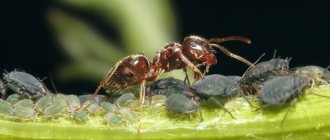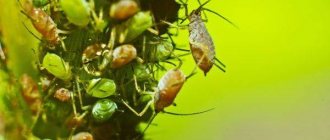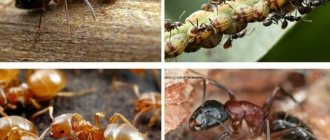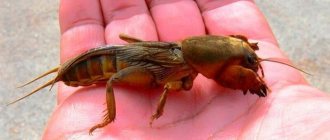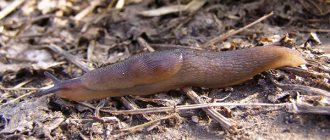If you notice gnawed stems of seedlings or eaten leaves, it means you have crickets in your garden. Let's look at how to get rid of them in detail. Around the beginning of April, at the dacha, as soon as evening comes, there are crickets. The chirping of crickets is directly associated with summer, but all the romance ends there, since in addition to the “songs” they cause significant damage to garden plantings. These insects have a good appetite and happily feed on all vegetables and cereals.
Black cricket close-up photo:
Crickets, for those who are not familiar with them, look like black grasshoppers in the garden, jumping just as briskly. Crickets in the garden, what harm do they do? These insects are omnivores; they cause the same damage to strawberry bushes, potatoes, corn, legumes, and other plants.
The harmfulness consists of damage to the root collar of the stem or the small plant being eaten entirely. On the fruits of raspberries and strawberries you can see chewed pulp.
Spraying the garden with chemicals is not always advisable, since the berries or vegetables will subsequently be eaten. If you follow certain rules, you can still use chemicals, but today there is a worthy bio-alternative.
What do crickets eat in the garden? The answer is everyone! In addition to their plant diet, these insects do not disdain their relatives, their larvae, worms, and dead animals. Even their own clutches of eggs, as well as young representatives of their species, can become “dinner” for adult insects.
An adult reaches a length of 1.5-2 cm and has a black body color. The black cricket (field) is the most common species of the cricket family.
Field cricket:
Field (black) cricket, photo
Secrets on how to get rid of black cricket
Despite the high effectiveness of using modern pest control agents, some gardeners prefer to use old and proven traditional methods. When asked how to get rid of crickets in the garden using folk remedies, there are several proven and effective remedies:
- Use of wormwood;
- Red hot pepper;
- Polyethylene film.
Sagebrush. In this case, you need to use a strong decoction to treat the soil. To work, you will need to take a medium-sized metal bucket, fill it with wormwood grass as tightly as possible, fill everything with water on top and put it on medium heat. You must wait until the water boils, then you need to remove the bucket from the heat and dilute the liquid again with water, in a ratio of one to four. With the prepared decoction, you should thoroughly scour the entire area of land, especially treat those places where you see insect burrows. Another option is to simply spread wormwood on the beds. The smell of this plant drives away such small pests.
Red pepper. The use of this pepper implies the need to sprinkle it on the soil near the stem of the plant. To increase the effectiveness of this method, you can mix pepper with tobacco. Next, also generously treat the area of land that is important to you with the mixture.
It’s not strange, but even plastic film will help get rid of annoying pests. This method is especially appropriate to use in the spring. It is known that these are heat-loving insects, so if you crumple up the film and spread its parts throughout the garden plot, then as soon as night falls, they will immediately crawl into the film and warm themselves. And as soon as morning comes, you can safely begin your hunt, the main thing is that you must act very quickly so as not to scare them away.
How to deal with crickets in the house?
These insects cause a lot of discomfort not only in the garden by eating the crop, but discomfort is also felt if they get inside the house. Therefore, the relevance of the question of how to get rid of crickets in the house is increasing.
The best answer to the question of how to get rid of crickets in an apartment is to make the house completely impenetrable. The simplest, but at the same time effective method to prevent the appearance of these musicians is to seal the doors and windows in the house as much as possible. These insects can enter the house through even the smallest cracks, so you should inspect the entire house with the utmost care, and then do the following:
- Eliminate all small cracks and seal the windows;
- As an option, you can purchase an addition to the front door, which is attached to the bottom so that insects cannot get through the door;
- Carefully inspect the plinth and if you find small cracks, be sure to close them;
- All ventilation must be covered with dense grilles.
When fighting such a small enemy, pay special attention to getting rid of their eggs. Yes, they can lay their eggs in the house, and this, as a result, can provoke their rapid reproduction
There are two valid methods to eliminate their eggs:
- Regularly treat the room with a vacuum cleaner that has a built-in filter that can trap the smallest particles. Only such a vacuum cleaner can completely remove eggs from the carpet or other places where they are present. After cleaning, the entire contents of the bag must be thrown into a tight sealed bag;
- Most sprays that are used to combat these insects also kill their eggs. It is best to spray the inside of the room with such products, or rather along the baseboards, where insects most often lay their eggs.
Watch an educational video on how to get rid of crickets and share your methods for getting rid of crickets in unwanted territory.
Useful tips
Knowing the peculiarities of a cricket’s life, the question of how to get rid of them in a garden or apartment can be easily resolved. It will help to expel the bugs by reducing favorable conditions for their reproduction to zero.
Necessary:
- close all water sources, do not leave wet places, fix dripping taps;
- get a cat or dog, four-legged animals will eagerly hunt for insects and destroy their nests;
- use a powerful vacuum cleaner to go through all the cracks, pulling out the eggs of crickets and their larvae;
- close all the cracks in the house.
If you cannot cope with the bugs on your own, invite specialist disinfectors. SES workers will quickly free you from pests.
As for the garden area, it should also be kept clean. After harvesting, do not leave unnecessary objects on the ground - building materials, film, fallen leaves and other debris. When digging up your garden, take out all the excess – weeds and plant debris.
The most effective means and rules for their use
You can get rid of wireworms using folk remedies. The experience of many gardeners speaks to this. To achieve good results, you need to approach the matter comprehensively. It is better to choose several methods you like and combine them.
Conifer needles
Conifer needles can be used as a deterrent. Add ash or humus, crushed eggshells and a handful of pine needles collected a couple of days before planting potatoes into the holes.
Potassium permanganate solution
The holes are filled with a solution of potassium permanganate before planting the crop, so as not to burn the roots of the plant (each should take about half a liter of liquid). Proportions for diluting the composition: 2 g of potassium permanganate per 10 liters of water.
Mustard or mustard cake
The wireworm does not like mustard, so it is often used in the garden against the pest:
- Dry mustard powder can be poured into each hole. For a more effective result, you need to add hot pepper to it.
- Mustard cake is used for wireworms in the following way: pour one tablespoon into the hole before planting potatoes. Soil is poured on top, and then they begin to plant the crop. This is done so that the potato roots do not come into contact with the cake.
- Wireworm mustard can be sown closer to September. After it grows, it needs to be cut and carefully dug up with soil. This will help repel the pest.
Ammonia
Dissolve 1 tbsp in 10 liters of water. spoon of product (18 ml). Spray the soil with a mixture of ammonia to remove wireworms immediately before digging at the rate of 1 liter of solution per 1 square meter of area.
Wood ash
Unique fertilizing for all crops helps increase their yield. It is scattered between the rows and brought into the hole during planting.
Optimal conditions for the appearance of woodlice on the site
Woodlice may choose a garden plot to colonize if it has suitable conditions for them. This may include:
- the presence of fallen trees on the site that have remained lying, and piled up boards that have already begun to rot;
- plant debris left for a long time near the beds and rags and other debris scattered throughout the garden;
- compost pit and open dump for organic waste within the site;
- excessively high humidity in the garden and inside greenhouse structures.
All this contributes to the appearance of woodlice in the garden. Most likely, they will then definitely move to the greenhouse, because it is there that is always humid, which is most optimal for their residence and active reproduction. As preventive measures in the fight against woodlice, or rather, with their appearance, the following are necessary:
- regular ventilation of the greenhouse;
- rationing of water consumption during irrigation;
- thinning the plantings to avoid thickening;
- timely removal of weeds, including from the passages between the ridges;
- loosening the soil and mandatory autumn digging.
Methods of disposal
Getting rid of the singing bug is not at all difficult. First you need to find it in the house. This means you need to listen to its chirping. Then approach him slowly and carefully, otherwise he will get scared and you will have to look for him again. Finding it during the day is very difficult, so it is better to do this at night.
Folk method
Instructions:
You can lure a cricket out in the most seemingly simple way. To do this you need to take a small container. Mix molasses, lemon balm and add a little water
This will definitely attract the cricket's attention.
Lighting sealing wax. The smell repels crickets. Therefore, the insect will quickly leave the house.
Do not leave water in the open. There should be no damp places in the house
A cricket will not live long without water. Therefore, he himself will go into his habitat.
Chemicals
All kinds of special sprays. They can be found in any store. The spray will help you quickly and easily direct the stream to the target. Once hit by a bug, it soon dies. The spray can be used to treat areas where small pests may be located.
Traps and bait
- Special baits.
They can be purchased at the store. The bait will help lure him out of the gap. - Sticky strips.
They are absolutely safe for human health. Sticky strips should be distributed where the cricket may be. He will definitely leave his house and fall into a trap.
Mechanical method
- A vacuum cleaner is a safe product.
If there are children or animals in the house, then this method is perfect. - Using smooth movements, cover the bug with the jar.
Not many are capable of killing. In this case, it is better to catch him and release him.
“A cheerful company sits behind the stove and, humming a song, moves its mustache!”
Half a century ago, there was a very popular song about four inseparable cockroaches and a cricket living behind an old man’s stove. What did the poor grandfather do to get rid of the annoying tenants! But nothing helped. He even blew up his stove with dynamite at the end of the song. But that didn't help either. According to the author of the hit of the last century, an inseparable company sat on a pile of stones and joyfully greeted their neighbor.
The song is a song, but it is also based on some facts. And questions naturally arise in my head. Why did this company not please the elderly man? And why did the cricket suddenly become friends with cockroaches? Let's try to find answers to them.
How a cricket becomes a person's neighbor
A cricket can settle in an apartment, house and adjacent areas.
Methods of entering a home
Interestingly, crickets can be found even on the upper floors of new buildings. There are several ways to “move” them into a living space:
- "Intelligence service". If one of the residents breeds “night musicians” for some reason, the insects can visit their neighbors after leaving the place of detention.
- "Moving". Crickets can get into the apartment along with food and things from the old place of residence.
- "Expansion of territory." If these insects have already settled in the garden, then nothing prevents them from looking into the house.
In order to “register” in a person’s home for a long time, a cricket, like any other living organisms, needs a constant source of food. This question is simple: insects are omnivores. Of course, in their natural environment they eat mainly plant foods, but sometimes they can also be predators, feeding on other insects.
Once in a human home, crickets do not face the problem of food. They are always happy with leftovers from the table. Slices of fruits, vegetables, bread crumbs, drops of drinks - an excellent diet. If there are pests in the apartment, such as cockroaches or moths, crickets will eat them too.
Field cricket in the garden
The field cricket likes to stay in summer cottages and gardens: this is natural, because the insect lives in nature, and trying to get closer to the source of food, it moves closer and closer to vegetable and fruit plantings, including penetrating into greenhouses, the humid climate of which is most suitable for it favorable
The field cricket is the most common species of the cricket family.
This lover of plant food can cause considerable damage to the crop, especially if there is a large group of crickets. Thanks to their good appetite, insects can easily harm a wide variety of plants. They will like:
- strawberry;
- cereal crops;
- corn;
- beans;
- tobacco;
- beet;
- carrot;
- onion;
- cabbage;
- potato.
Life cycle, reproduction of an insect
Crickets become sexually mature a month after hatching. These insects are able to reproduce in warm weather. Their development occurs in the following stages:
- egg;
- larva;
- adult insect.
Females lay eggs in places hidden from unwanted eyes. This can be soil, earth, or eggs can also be found under stones. They are small in size and yellowish in color. Temperature plays a big role in how many eggs a female lays. If it changes dramatically, there will be fewer eggs. Insects consume plant food, fruits, vegetables, berries, bran, bread, fish food, meat or even fish.
Pest control: drugs and methods
To protect vegetable gardens from this insect, complex measures are practiced - agrotechnical and chemical. Loosening the soil and thoroughly digging it in the fall slightly reduces the number of pests.
Also, to reduce the number of insects, the area is treated with Nemabact or Antonem-F. These are biological products, they are considered safe for humans, pets, birds, and plants. These products give good results and are very effective.
The test results showed that 4 days after treatment, 78% of crickets die, and after 30 days - 100%. Before fighting crickets in the garden, the drug is diluted with warm water 1:100; in terms of temperature, it should be similar to the soil on the site. Irrigate the soil directly, preferably during rain, in the late afternoon. The container with the composition must be shaken periodically, and after treatment, additionally water the entire area (to facilitate the penetration of the drug deep into the soil). These preparations can be sprayed on the ground even during the growing season of plants.
If you choose chemicals, then before poisoning pests in your garden, carefully read the instructions. It is always necessary to maintain the prescribed period so that the drug completely “comes out” of the plant before eating the fruit. For such purposes, “Karbofos” (8-10 ml per 10 liters of water) or “Decis” (3 ml per 10 liters of water) is most often used.
Prevention of caterpillars in the greenhouse
I try to prevent pests from living in the greenhouse - it’s much easier and safer than resisting them. I recommend simple preventive measures:
- At the end of the season, I clean up all the plant debris in the greenhouse - there may be pest eggs on them. I burn garbage in an iron bin.
- Every autumn I carry out a deep digging of the greenhouse soil - the larvae, cutworm pupae and whiteflies overwinter in the substrate. If caterpillars occupied the greenhouse last season, the top layer of soil (at least 15 cm) should be removed and replaced with fresh, uninfected soil.
- In the spring, I always disinfect the greenhouse soil - I water it with a saturated manganese solution or boiling water.
- I carry out weeding in a timely manner - caterpillars often settle on weeds, after which they crawl onto cultivated plants.
- I try to water the seedlings at the root. I carry out water procedures in the morning - the moisture has time to evaporate by the evening. This is necessary so as not to create warm, high humidity that is comfortable for the caterpillars.
- If there are self-pollinating plants in the greenhouse, I make barriers to the penetration of insects on the doors and windows - gauze, tulle curtains, mosquito nets.
- I carry out preventive treatments with Decis and Cytcor. I usually act in two stages - I plan to spray again after 1 week.
Caterpillars are small but very voracious pests. If you do not confront them in time, uninvited guests will destroy your greenhouse plantings and leave you without a harvest. Try to prevent caterpillars from appearing in the greenhouse - do not forget about simple but effective prevention.
How to get rid of night singers
If the romance of crickets' trills does not seduce the owners, then the only way left is to expel them from the house forever, choosing the method that suits you.
We act without the use of chemicals
Try going without chemicals first:
- If you don’t want to kill the “singer” for superstitious reasons, catch him and release him into nature. True, this is problematic to do, since crickets appear only in the dark; in the light they quickly jump and hide in cracks.
- Try placing sticky traps in areas where you hear the chirping more often.
- Pour a couple of tablespoons of molasses or molasses into a bowl and leave in a warm, humid place. Insects will like this. Please try again in 2 days.
- A proven folk remedy is the smoke from burning sealing wax, which drives out pests at least until next year, the breeding season.
- A cricket has appeared in the house, which means there is a cat missing. The fluffy pet will quickly catch the annoying “singers”.
- Natural enemies of crickets are lizards and starlings. It is not difficult to make a birdhouse on the territory of a private house, or you can try to house a lizard.
- To kill cricket eggs, use a vacuum cleaner with a HEPA filter or ultraviolet treatment. Just don’t forget to knock out the dust collector outside so as not to make the situation worse.
Photo gallery: simple ways to get rid of crickets
Regular cleaning with an effective vacuum cleaner can destroy cricket eggs The glue trap is easy to use Cats, lizards, starlings are helpers in the fight not only against crickets Crickets jump straight into a bowl when they find a treat made from molasses or molasses
How to get rid of crickets in an apartment using chemical insecticides
If a whole population of crickets has already appeared in a house or apartment, you cannot do without chemicals
. Use potent poisons made on the basis of dichlorvos - “Neo”, “Varan” and others.
Before starting work, close the doors and windows tightly, shake the can and spray the substance at a distance of 30 cm from the surface. Treat places where insects were most often seen, as well as all corners, window frames, and baseboards. Ventilate the room well for half an hour, and after that it is advisable to leave the house for a day or more.
When working, use safety glasses and a respirator, take children and pets out of the room.
After 40-70 days, repeat the treatment as young crickets hatch during this period.
How to recognize a cricket at first sight and sound
The appearance of house crickets resembles other unwanted guests of residential premises - cockroaches. This is natural because they are relatives and belong to the same Orthoptera family. Grasshoppers and locusts are also considered to be their relatives.
There are almost 4 thousand species of crickets around the world. Most prefer hot countries with a humid climate. Only 40 varieties can be found in the CIS. Of these, the most famous and most often seen are:
- field cricket, living in fields, meadows and deciduous forests;
- a brownie that chooses to be close to a person, climbing into a dwelling and adjacent buildings.
The cricket is a representative of the Orthoptera order.
In their natural environment, crickets often live in close proximity to people. They choose to live in dilapidated buildings with high humidity and many cracks. House crickets love:
- warm basements;
- warehouse and industrial premises;
- heating plants.
During the cold season, insects move to more comfortable (warm) conditions.
The diet of a cricket depends on its habitat. In nature, he eats plant foods, and in the house he can “feast” on leftovers from a person’s table.
Insect portrait
The body of the cricket is small, slightly flattened, covered with a hard shell of a yellowish-straw color. There is also a darker color with a peculiar pattern of specks, spots and streaks. The head is shaped like an egg. The eyes are located on the sides. The main distinguishing features of the insect portrait are its long mustache. They are often larger than the cricket itself.
Externally, a cricket is similar to a grasshopper, but they differ in the way they fold their wings
For active movement, the cricket has three pairs of legs and well-developed wings. Actually, the structure of the latter contains the exceptional musical abilities of these insects.
How and why do crickets sing?
Chirping sounds are made exclusively by males to attract individuals of the opposite sex during the mating season, as well as to mark boundaries and intimidate the enemy. The mechanism for the appearance of the “song” is associated with the structure of the wings, namely with the presence of veins and folds on them that produce a characteristic sound. When the wings touch, vibration occurs and a chirping sound appears. The principle is very similar to the interaction between the bow and strings of a violin.
The cricket's "musical instrument" has a more complex structure than that of the grasshopper. Therefore, its trill is more diverse in terms of melody and tonality.
The principle of “playing” music with wings is very similar to the interaction of the bow and strings of a violin
Is the cabbage butterfly a pest or not?
Inexperienced gardeners are often perplexed as to why so many white butterflies appear on raspberries. Are they pollinators, or are they dangerous pests that can destroy a large percentage of the crop? A simple-looking butterfly actually helps pollinate raspberry bushes, but at the same time the insect lays larvae. This is where the main danger lies.
Females lay orange eggs on the reverse side of the leaf. The larvae hatch from them and actively devour leaf tissue, buds and flowers. If you start the process, the caterpillars will make holes in the entire green mass. Because of this, the raspberry bush weakens; it no longer has enough strength to grow full-fledged berries.
Raspberry pests that gnaw leaves to the point of “skeleton” are the caterpillars of the hawthorn butterfly. They are very common in gardens and wildlife and are confused with another pest, cabbage grass. These two insects have differences:
- The hawthorn is a butterfly with white wings covered with thin black stripes, while the cabbage has black spots and corners on its wings.
- The larvae are also different - in hawthorn the caterpillar has noticeable pubescence.
- And one more thing: cabbage’s favorite food in the garden is the Cruciferous family (cabbage, radishes, etc.), and hawthorn eats fruit trees and shrubs (rowan, hawthorn, pear, etc.).
When can we expect hawthorn to appear?
This butterfly emerges from the pupa in May-June (the warmer the climate, the earlier). Approximately once every 4-6 years, due to natural reasons, the number of these insects increases. If a wet summer is predicted, then it is worth carrying out preventive procedures in the garden in early spring.
How to prevent guests from returning
Sealing all cracks and cracks through which crickets can enter the house will help prevent re-infestation. Insects can enter a room if there are cracks and holes in the floor and baseboards near the sewer pipes.
Mosquito nets are attached to the windows so that insects cannot get into the home. The corners near the batteries are also treated with special sprays to effectively destroy the larvae. Be sure to close the trash can tightly so as not to attract the smell of crickets. It is important not to leave crumbs on the table and immediately remove leftover food. Dampness in the premises is unacceptable. It is imperative to warn employees of the management company or sanitary service employees about the accumulation of water in the basements. Residents of lower floors or private houses require special attention. In the evenings, it is necessary to close the curtains and lower the blinds so as not to attract uninvited guests from the world of insects with bright light. To illuminate the yard, it is recommended to use medium-power lamps, preferably yellow light. Ventilation grilles are covered with fine mesh. Compost heaps should be located at a distance from private houses, in the far corners of the plots. The greenery near the home is trimmed regularly; climbing plants are not recommended to be planted close to the home. If night trills do not cause insomnia, and the appearance of insects does not seem repulsive, then the neighborhood can be quite pleasant
However, there are ways to get rid of restless guests. And they should be used so as not to turn life into constant stress.
If night trills do not cause insomnia, and the appearance of insects does not seem repulsive, then the neighborhood can be quite pleasant. However, there are ways to get rid of restless guests. And they should be used so as not to turn life into constant stress.
(1 vote, average: 5 out of 5)
Having settled in a house, a cricket can bring not only happiness and prosperity, as folk signs promise. Musical “arias” at night are not always pleasant for residents and often interfere with normal sleep. There are several methods for solving the problem of how to get rid of crickets in an apartment, which will help in such a situation.
Description of crickets and the reasons for their entry into homes
In order to choose the right tactics for pest control, it is important to know their characteristics, favorite habitats and habits. Crickets belong to the order Orthoptera, they have a squat body and long hind legs that allow them to move by jumping
Adults reach 2 cm in length, have a yellow-gray body color and mustaches on the head.
It is mainly house crickets that penetrate into human housing, which can be found both in the garden plots of private houses and in apartments of high-rise buildings. In nature, they live in dense greenery, and in the home they settle in secluded corners. To build a nest, they choose dark, damp and warm places.
Pests feed on leftover food, indoor plants, and also eat small insects (moths, mosquitoes, etc.). They can damage textiles, paper products and furniture.
During the day, crickets hide in secluded corners, and at night they go out hunting, emitting characteristic melodic sounds.
Insects rarely appear in apartments, but in search of food and warmth they can crawl into homes and live in rooms or basements. As a rule, this phenomenon occurs when the outside temperature drops sharply in summer or autumn. Pests are attracted to the house by high humidity, an abundance of food, unsanitary conditions (the smell of rotting garbage), and bright light at night. Ways for insects to enter the house are open windows and doors, cracks, and ventilation holes.
What harm do they do?
Crickets are omnivorous and cause enormous damage to garden plants.
In addition to the remains of human food, worms and small insects, the bugs eat leaves and root stems of plants.
They cause the most damage:
- strawberries;
- potatoes;
- corn;
- legumes;
- tobacco;
- wheat;
- rye;
- beans;
- beets;
- carrots;
- onion;
- tomatoes;
- cabbage
In terms of damage, a cricket invasion can be compared to its closest relative, the locust. These insects can leave a gardener without any hope for a harvest in a very short time.
In Asian and African countries, crickets are bred specially. These insects are eaten (their bodies are rich in calcium and protein). They even make chips from them.
A million troubles because of a larva
What can compare with the most delicate blossoming of the first daffodils or crocuses, breaking through the snow in early spring and touchingly stretching their fragile buds towards the sun? Only the same fragile beauty in the middle of winter, when the heart yearns for the summer sun.
The most expensive gift for any holiday will be a bouquet that appears as if from a fairy tale.
And such a miracle is quite real; many people who are interested in floriculture like to surprise their friends and acquaintances by growing bulbous flowers all year round in heated greenhouses. Someone turns a hobby into a very profitable business, selling not only bouquets, but also bulbs and children, receiving several harvests throughout the year.
But flower growers never run out of worries before the birth of a miracle. One of them is the fight against the most dangerous pest - the larva of the click beetle, which can destroy almost all the bulbs of flowers planted in an infected greenhouse.
A tiny paradise under glass among the snow or slush of the off-season can delight owners and surprise guests every day and hour. And how could it be otherwise: strong stems make their way to the sun in even rows in the greenhouse, buds open in all their variety of colors and shapes.
And suddenly a picky eye notices some kind of discrepancy - against the background of general well-being, the drooping stem of one flower, fallen petals on another, wilted leaves on several more do not yet look like a disaster. But they talk about its probable beginning.
The disease and death of several plants of the same or different varieties, located quite far from each other, if the rest look completely healthy, may indicate damage to the soil by pests called wireworms.
IMPORTANT! The worms, which look like pieces of copper wire, have their own name, although they are just the larvae of one of the varieties of the beetle - the click beetle. The beetle itself is safe, but the larvae can turn a gardener’s life into hell, eating and mutilating the underground part of all plants, tubers and bulbous flowers are especially affected.. Small, 2-4 cm in length larvae, hatched from the eggs of a click beetle, in the first year invisible and almost non-threatening
Small, 2-4 cm long larvae, hatched from the eggs of the click beetle, are invisible in the first year and pose almost no danger.
In the second year of their life cycle, they become very active, voracious and acquire a yellowish color.
The hard body is difficult to crush; because of this feature and color, the beetle larva is called a wireworm.
You can learn more about this pest in a special article!
conclusions
If insects appear in the house, they need to be exterminated immediately, since this will become more and more difficult every day. When choosing a method of control, you need to take into account exactly where the crickets appeared. After the initial cleansing of the space, you need to make sure that there are no eggs, otherwise they also need to be destroyed immediately.
In appearance, crickets are not at all scary, and even very cute. But they cause harm like a mole cricket. In addition, there are much more crickets and they are not used as bait for mole crickets, although they are close relatives.
Crickets have an enviable appetite: they gnaw seedlings, eat leaves and stems of seedlings and melons. In general, they harm melons and melons most of all, but they can also feast on other vegetables. Crickets are considered omnivorous insects and greatly damage both strawberries and potatoes. Crickets do not disdain insects and their larvae; even their own clutches and young crickets can become dinner for their adult counterparts. Digging the soil in the fall slightly reduces the number of crickets, but does not fundamentally solve the problem. We have to resort to chemicals. For example, Karbofos or Actellik. It is used to treat soil and plants where crickets are especially harmful to the crop. In the fall, the area must be kept clean, as crickets love to hibernate under layers of film or wooden fragments. Good results are obtained by using box baits for insects, either helium or granular - they are laid out in places where there is a large number of pests. You can also use folk remedies. With wormwood infusion, you can treat soil that is heavily dug up by crickets - they will leave their favorite bed. After a week, we dig up the soil and spray it again with wormwood infusion. The method is certainly not a panacea, but it can significantly reduce the number of this pest. Crickets are very heat-loving insects. Therefore, if you lay out film in the garden, they will get into its folds. All that remains is to show a little dexterity by collecting them in a solution of salt in water. Hunting is carried out in the morning, when insects are inactive. You can also attract crickets with beer. Why are its cups buried in the soil up to the neck? Crickets gather at its smell and drown in it. While there are few crickets, they can be exterminated mechanically and using traps. But these are very prolific insects and soon there may be an indecent number of them, then it is necessary to use chemicals and not just once, but twice - with an interval of 1.5-2 weeks. Only the last treatment must be carried out 30 days before harvesting.
New from users
It's no secret that foreign varieties of strawberries are now at the peak of popularity. Gardeners are ready to give for them...
Harvesting before sowing: what perennials do I give...
Previously, everything was simple: to have early greens, they planted onions, root parsley and sorrel. Now everything is more complicated...
This is because they can destroy not only ordinary pests, but also underground ones - wireworms and mole crickets...
Prevention
There are no special measures to prevent the spread of these insects. Crickets love damp places, so they often settle in swampy lowlands. If you create unsuitable conditions on a site, insects will leave it, but on the other hand, watering is vital for plantings, so periodic moistening is essential.
Crickets are omnivores, so they have no particular preference for vegetation. It has been noticed that they cannot tolerate the smell of wormwood, so several bunches of this grass scattered between the rows will repel pests well.
Another problem can be aphids, but here’s how to spray an apple tree against aphids, and what chemicals can be used. This will help you understand
In addition, an observant person will note holes in the ground where insects live. In addition, pests love wooden boards, old furniture and other wooden objects. For crickets, this is an excellent chance to provide shelter for their larvae, and for the gardener it is an additional threat.
This is why it is recommended to remove or replace wooden building materials when there is a large cricket infestation. The insects will have nowhere to lay their larvae and, perhaps, they will leave the area in search of a more suitable place. It will also be useful to learn about which means are the most effective.
